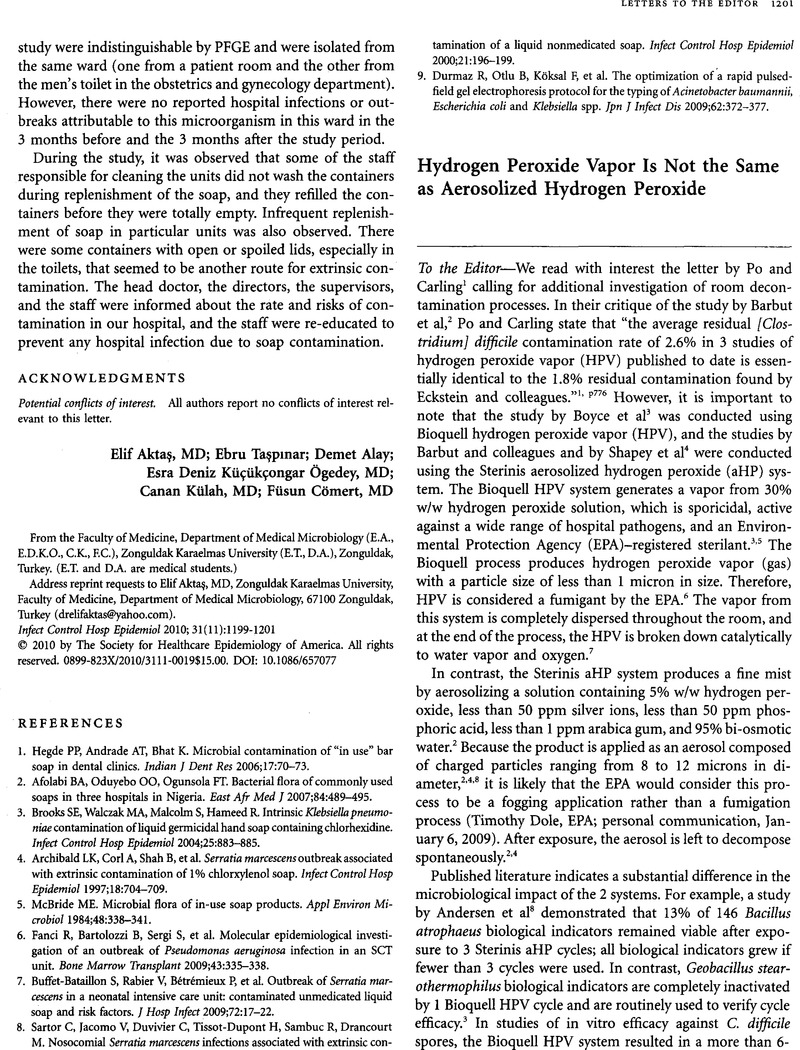Crossref Citations
This article has been cited by the following publications. This list is generated based on data provided by Crossref.
Holmdahl, T.
Lanbeck, P.
Wullt, M.
and
Walder, M. H.
2011.
A Head-to-Head Comparison of Hydrogen Peroxide Vapor and Aerosol Room Decontamination Systems.
Infection Control & Hospital Epidemiology,
Vol. 32,
Issue. 9,
p.
831.
Gordon, Diane
Carruthers, Bree-Ann
and
Theriault, Steven
2012.
Gaseous Decontamination Methods in High-containment Laboratories.
Applied Biosafety,
Vol. 17,
Issue. 1,
p.
31.
Fu, T.Y.
Gent, P.
and
Kumar, V.
2012.
Efficacy, efficiency and safety aspects of hydrogen peroxide vapour and aerosolized hydrogen peroxide room disinfection systems.
Journal of Hospital Infection,
Vol. 80,
Issue. 3,
p.
199.
Otter, J.A.
Yezli, S.
Perl, T.M.
Barbut, F.
and
French, G.L.
2013.
The role of ‘no-touch’ automated room disinfection systems in infection prevention and control.
Journal of Hospital Infection,
Vol. 83,
Issue. 1,
p.
1.
Otter, J.A.
Yezli, S.
Perl, T.M.
Barbut, F.
and
French, G.L.
2014.
Decontamination in Hospitals and Healthcare.
p.
413.
Adams, N.
and
Chewins, J.
2016.
Response to ‘Cleaning up after carbapenemase-producing organisms’.
Journal of Hospital Infection,
Vol. 94,
Issue. 1,
p.
107.
Otter, J.A.
Yezli, S.
Barbut, F.
and
Perl, T.M.
2020.
Decontamination in Hospitals and Healthcare.
p.
323.
Wang, Zixu
Kowal, Shawn F.
Carslaw, Nicola
and
Kahan, Tara F.
2020.
Photolysis‐driven indoor air chemistry following cleaning of hospital wards.
Indoor Air,
Vol. 30,
Issue. 6,
p.
1241.
McKew, Genevieve
Phan, Thuy
Cai, Tina
Taggart, Susan
Cheong, Elaine
and
Gottlieb, Thomas
2021.
Efficacy of aerosolized hydrogen peroxide (Deprox) cleaning compared to physical cleaning in a Burns Unit.
Infection, Disease & Health,
Vol. 26,
Issue. 3,
p.
161.
Truitt, Christopher L.
Runyan, Debra A.
Stern, John J.
Tobin, Carolyn
Goldwater, Wesley
and
Madsen, Rodney
2022.
Evaluation of an aerosolized hydrogen peroxide disinfection system for the reduction of Clostridioides difficile hospital infection rates over a 10 year period.
American Journal of Infection Control,
Vol. 50,
Issue. 4,
p.
409.
Silva, Kamila Jessie Sammarro
and
Sabogal-Paz, Lyda Patricia
2022.
A 10-year critical review on hydrogen peroxide as a disinfectant: could it be an alternative for household water treatment?.
Water Supply,
Vol. 22,
Issue. 12,
p.
8527.
Sammarro Silva, Kamila Jessie
Lima, Alessandra Ramos
Corrêa, Thaila Quatrini
Dias, Lucas Danilo
and
Bagnato, Vanderlei Salvador
2023.
Hydrogen peroxide as an additive to curcumin on the photodynamic inactivation of bacteria: a preliminary study.
Laser Physics,
Vol. 33,
Issue. 8,
p.
085601.
Ayub, Aaqib
Cheong, Yuen Ki
Castro, Jesus Calvo
Cumberlege, Oliver
and
Chrysanthou, Andreas
2024.
Use of Hydrogen Peroxide Vapour for Microbiological Disinfection in Hospital Environments: A Review.
Bioengineering,
Vol. 11,
Issue. 3,
p.
205.



